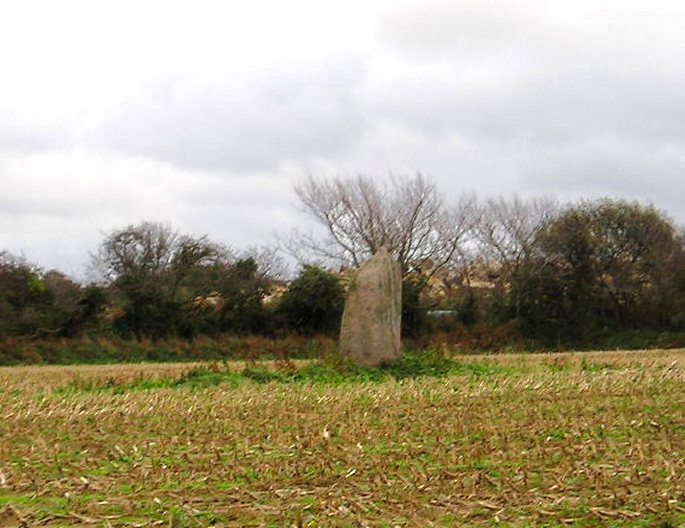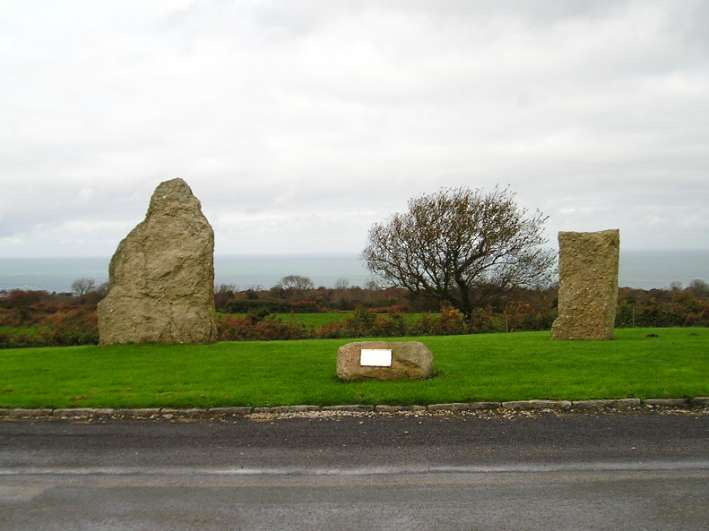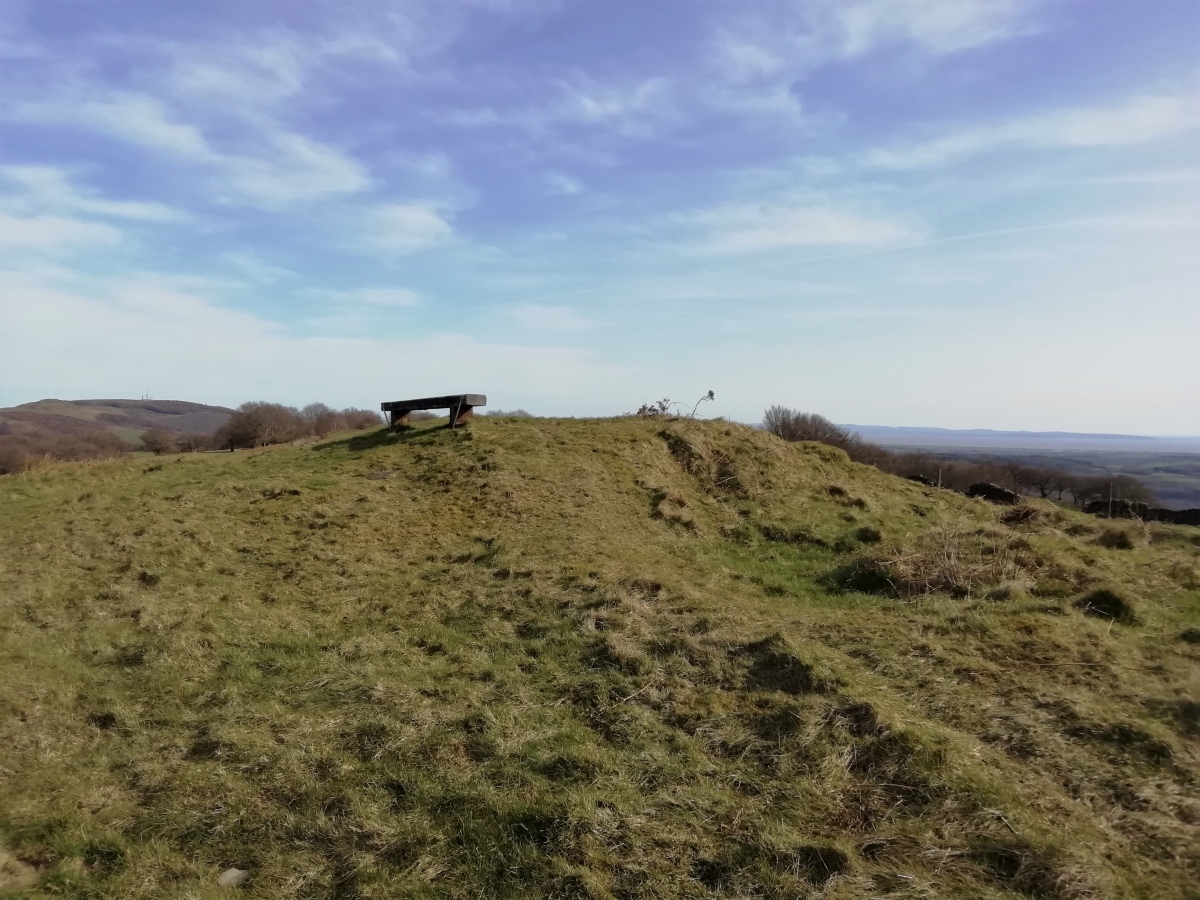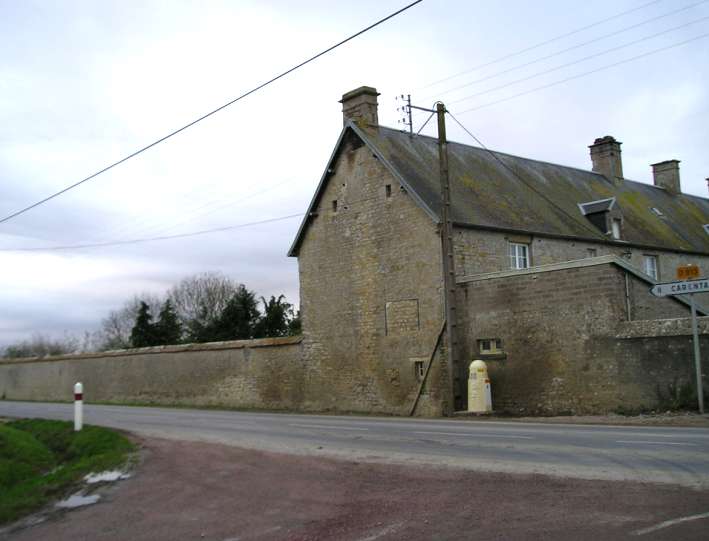Contributory members are able to log private notes and comments about each site
Sites TheCaptain has logged. View this log as a table or view the most recent logs from everyone
Pierre au Rey
Trip No.201 Entry No.18 Date Added: 25th Mar 2020
Site Type: Burial Chamber or Dolmen
Country: France (Normandie:Manche (50))
Visited: Yes on 22nd Nov 2004. My rating: Condition 3 Ambience 4 Access 5

Pierre au Rey submitted by thecaptain on 6th Dec 2004. La Pierre au Rey dolmen on the clifftops at Flamanville in Normandie, seen in its cafe garden from the southeast. The stones in the foreground are thought to have once been part of an entrance structure.
(View photo, vote or add a comment)
Log Text: Perched high on the cliff top near Cap de Flamanville can be found this strange antiquity, situated in the small garden behind a café, right on the cliff edge. Easily found to the west of Flamanville, just follow signs to “Semaphore” and where the road runs out there is a car park and picnic site as well as the café.
It consists of four large rounded rocks, and doesn’t look like any other dolmen I have ever seen. At first, the rocks look like natural big rounded pebbles, in some kind of pile, but how did they get there like that ? Closer inspection reveals several other stones on the landward side, obviously placed in their position, which would have at one point formed some kind of entranceway to the main chamber, which consists of three large rocks forming a triangular shape, with the fourth rock balanced on top.
A couple of the large rocks have carvings on them, including a human form on the top boulder, but it is unknown as to whether these carvings are ancient or from more modern times, when it was used as a lookout point by the customs men. Some theories suggest that this is not a dolmen in the usual sense of the word, but some kind of ancient seagoing navigational mark.
There were in years gone past, other megalithic monuments in this area, in the form of large menhirs now destroyed, but of which the names and records survive. One of these called La Pierre-aux-Serpents, was 9 metres in height, but was destroyed around 1725 during construction of the chateau. Another, to the southeast at Percaillerie, was 5 metres in height but destroyed in 1890. It is also thought that there may once have been another of these cliff top dolmens at Corb to the north, destroyed before 1880 and of which no trace remains today under the nuclear power station.
Pierres Tournantes (Néretz)
Trip No.201 Entry No.17 Date Added: 25th Mar 2020
Site Type: Standing Stones
Country: France (Normandie:Manche (50))
Visited: Couldn't find on 22nd Nov 2004
Log Text: Marked on the IGN Top 25 map as being beside a lane in a wooded area near to the Château de Néretz just to the west of the village of Teutheville-Hague, are these two menhirs, said to be 3 metres in height. However, the lane shown on the map turned out to be a gated private driveway, and so I spent no further time looking for these stones.
Fort Joret allée couverte
Trip No.201 Entry No.16 Date Added: 25th Mar 2020
Site Type: Passage Grave
Country: France (Normandie:Manche (50))
Visited: Yes on 22nd Nov 2004. My rating: Condition 2 Ambience 3 Access 4

Fort Joret allée couverte submitted by thecaptain on 21st Jan 2005. Allée Couverte de Fort Joret, Fermanville, Manche.
The view from the coastal footpath along the edge of the beach from the south.
(View photo, vote or add a comment)
Log Text: In a field overlooking the sea, with splendid views over the rocky beach, can be found the remains of this very ruinous Allée Couverte. It is about 500 metres along the coast path to the southwest of Fort Joret, in the Commune de Fermanville, just a few miles east of Cherbourg.
Estimated to have originally been about 17 metres in length, it runs in a north to south direction. The northern part of the remains are very ruined, with only a few stones here and there laying on the ground. The southern part of the tomb is in much better, but still very ruined and overgrown condition, and difficult to get to see in detail. The width of this part is much greater than the northern part, of the order 2.5 metres, and several large slabs remain in position.
Pierre Plantée (Cosqueville)
Trip No.201 Entry No.15 Date Added: 25th Mar 2020
Site Type: Standing Stone (Menhir)
Country: France (Normandie:Manche (50))
Visited: Yes on 22nd Nov 2004. My rating: Condition 3 Ambience 3 Access 4

Pierre Plantée (Cosqueville) submitted by thecaptain on 30th Dec 2004. La Pierre Plantée, Cosqueville, Manche.
Side on view of this 3 metre tall stone, looking roughly south, and the quarry workings can be seen behind the hedge.
(View photo, vote or add a comment)
Log Text: In a field to the south of the road running east out of Cosqueville can be seen this large menhir, 3 metres in height. It is possible to park nearby, and I walked round the edge of a field to get a nearer view of the stone which is in the middle of a field beside a quarry. It is a nicely shaped stone, looking to be wider at the top than the bottom, with a sort of nob on the top, and with grooves running down its sides, probably due to rain erosion.
La Haute Pierre (St-Pierre-Eglise)
Trip No.201 Entry No.14 Date Added: 25th Mar 2020
Site Type: Standing Stone (Menhir)
Country: France (Normandie:Manche (50))
Visited: Yes on 22nd Nov 2004. My rating: Condition 3 Ambience 3 Access 3

La Haute Pierre (St-Pierre-Eglise) submitted by thecaptain on 22nd Dec 2004. In a field to the northeast of St-Pierre-Eglise is this large menhir, almost 3 metres in height. Getting closer would have meant walking through an absolute stinking swamp at the field gateway. So I satisfied myself with a long distance view.
(View photo, vote or add a comment)
Log Text: In a field to the northeast of St-Pierre-Eglise can be seen this large menhir, almost 3 metres in height. It is probably possible to get to fairly nearby, but it would have meant walking through an absolute stinking swamp caused by cattle at the field gateway. So I satisfied myself with a long distance view from the higher road beside a small chapel, a distance of about 100 metres for my photograph.
La Longue Pierre (St-Pierre-Eglise)
Trip No.201 Entry No.13 Date Added: 25th Mar 2020
Site Type: Standing Stone (Menhir)
Country: France (Normandie:Manche (50))
Visited: Yes on 22nd Nov 2004. My rating: Condition 4 Ambience 3 Access 4

La Longue Pierre (St-Pierre-Eglise) submitted by thecaptain on 22nd Dec 2004. La Longue Pierre, St-Pierre-Eglise. Seen here from the gate into the field.
(View photo, vote or add a comment)
Log Text: In a field beside a small lane to the north of St-Pierre-Eglise can be found this large menhir. It is signposted from the larger road running north towards Cosqueville, but I found nowhere to park up the small lane, so had to return to the larger road to park and then walk the few hundred metres back to the stone.
It is a very large stone, which stands at 4.2 metres high, perhaps the largest menhir remaining standing in Manche today. It is of roughly square section with an angled top. It is about 50 metres into a field beside the lane, and although many people had obviously been in to have a closer look, there was a sign requesting nobody enters the field, so I just looked from the gate.
Maupertus menhir
Trip No.201 Entry No.12 Date Added: 25th Mar 2020
Site Type: Modern Stone Circle etc
Country: France (Normandie:Manche (50))
Visited: Yes on 22nd Nov 2004. My rating: Access 5

Maupertus menhir submitted by TheCaptain on 27th Sep 2007. On the main street through Maupertus-sur-Mer, is a large granite stone being used as a gatepost.
The stone looks very weathered, and is twice as high as it would need to be for the gatepost function it provides.
Is this one of the many ancient menhirs that used to be in this area reused ?
(View photo, vote or add a comment)
Log Text: On the main street through Maupertus-sur-Mer, just to the north of Cherbourg Airport is a large granite stone being used as a gatepost. The stone looks very weathered, and the edges are curved and worn, not straight or with any quarrying marks. It is also twice as high as it would need to be for the gatepost function it provides. Is this one of the many ancient menhirs that used to be in this area reused ?
Grande et Petite Pierre
Trip No.201 Entry No.11 Date Added: 25th Mar 2020
Site Type: Standing Stones
Country: France (Normandie:Manche (50))
Visited: Yes on 22nd Nov 2004. My rating: Condition 4 Ambience 3 Access 5

Grande et Petite Pierre submitted by thecaptain on 23rd Dec 2004. La Grande Pierre et La Petite Pierre, Maupertus, Manche.
Recently re-erected in a little grassy area after being flattened to build Cherbourg airfield during the second world war.
(View photo, vote or add a comment)
Log Text: In a grassy area on high ground at the northwest end of Cherbourg Maupertus airport can be found these two lovely and massive menhirs made of a sort of puddingstone slab. Originally these large menhirs were related to a large burial tumulus, but during the second world war this tumulus and the stones were flattened to make way for the airfield.
In fairly recent times, the two large stones have been recovered and re-erected just outside the perimeter of the airport for all to see and enjoy. La Grande Pierre stands at 4 metres in height, and is about 2 metres in width at the base tapering to a pointed top. La Petite Pierre is very rectangular in shape, and stands at about 2.5 to 3 metres tall, although it looks to me like the top has been broken off.
Bretteville Allée Couverte
Trip No.201 Entry No.10 Date Added: 25th Mar 2020
Site Type: Passage Grave
Country: France (Normandie:Manche (50))
Visited: Yes on 22nd Nov 2004. My rating: Condition 4 Ambience 3 Access 5

Bretteville Allée Couverte submitted by thecaptain on 7th Dec 2004. L'Allée Couverte de Bretteville, just to the east of Cherbourg, Normandy.
Seen here from its western side.
(View photo, vote or add a comment)
Log Text: To the southeast of Bretteville, just a few miles east of Cherbourg, can be found the Allée Couverte de Bretteville, also known as “La Sepulture a Entrée Laterale de Bretteville-en-Saire”. It is clearly signposted from the D.901 road, and has its own little field and car park.
About 16 metres in length, it runs in a NW - SE direction with internal width and height about a metre, and has seven capstones still in place. The entrance is to the side of the allée at the south near the southeast end, and this leads in to a lovely portal holed doorstone blocking off the major northern part of the chamber. The southeast end of the monument has several lateral slabs radiating outwards from the main structure.
A very nice monument to visit, but it’s a pity about the rubbish and graffiti from which it suffers.
Galerie des Forges
Trip No.201 Entry No.9 Date Added: 25th Mar 2020
Site Type: Passage Grave
Country: France (Normandie:Manche (50))
Visited: Couldn't find on 22nd Nov 2004
Log Text: The remains of a third Allée Couverte said to be found to the northeast of Rocheville, in the Bois de la Tombette, at the foot of a hill northeast of a track called La Chasse-aux-Forges, but which are difficult to find.
Well, with my luck at finding these Normandie megaliths, and with a full day planned for hunting down other sites, I drove past the suggested area in the vain hope of seeing a signpost or similar (some chance!) but in the absence of which I spent no more time looking. The Allée Couverte is reported to be 16 metres in length, with an east west aspect, width and height 1 metre, closed at the east, open to the west.
Allée Couverte de Câtillon
Trip No.201 Entry No.8 Date Added: 25th Mar 2020
Site Type: Passage Grave
Country: France (Normandie:Manche (50))
Visited: Couldn't find on 22nd Nov 2004
Log Text: The remains of a second Allée Couverte is said to exist to the southeast of Rocheville, a few hundred yards from the Allée Couverte de la Petite Roche, just outside the Bois de la Grosse Roche, near the hamlet of Catillon.
It is said to be 17metres in length, southwest to northeast aspect, with a side entrance, and also with a dolmen type structure at the northeastern end. I had a good look round all the lanes and trackways in the Catillon area, but could not find anything. The one person I found to ask knew nothing of it.
Is it possible that this monument has been destroyed ?
Petite Roche allée couverte
Trip No.201 Entry No.7 Date Added: 25th Mar 2020
Site Type: Passage Grave
Country: France (Normandie:Manche (50))
Visited: Yes on 22nd Nov 2004. My rating: Condition 3 Ambience 4 Access 5

Petite Roche allée couverte submitted by thecaptain on 27th Dec 2004. Allée Couverte de la Petite Roche, Rocheville, Normandie.
Most of the remains are seen here in this view from the southeast.
(View photo, vote or add a comment)
Log Text: In the woods around the village of Rocheville can be found the remains of three Allées Couverte, only one of which is marked on the IGN maps, which is known as the Allée Couverte de la Petite Roche. To the southeast of Rocheville is a wooded area known as Bois de la Grosse Roche, and in the southwest corner of this wood, almost right beside the lane, is found the Allée Couverte de la Petite Roche.
About 20 metres in length, it runs in an east west direction. The width between the stones, of which there would have been about 20 in each row, is between 1 and 1,5 metres, and the height is about the same. At the east end of the allée the end stone remains in place, while at the west end it is open, but with a large stone across the rows about 3 metres distant, possibly a removed roofstone. About 5 cover stones remain in position, in two groups, two near the east end, and the other three nearer to the west end. There are many other stones lying around in the wood, probably some parts of the monument.
Twyn-Yr-Oerfel A
Date Added: 22nd Mar 2020
Site Type: Round Barrow(s)
Country: Wales (Monmouthshire)
Visited: Yes on 21st Mar 2020. My rating: Condition 3 Ambience 3 Access 4

Twyn-Yr-Oerfel A submitted by TheCaptain on 25th Mar 2020. The easterly of the two barrows, this one is the more ruined, but easily found and identified. It has a large pit dug into the top and a bench positioned on the top.
The views from up here would be terriffic, but the whole area is not a great place to be with so many off road tracks all around making the whole area a mess of mud.
(View photo, vote or add a comment)
Log Text: The fourth and last cairn marked on the OS Map during a walk from the Sirhowy Country Park around the Cwmfelinfach valley, up the Sirhowy River and back along the Rhymney Ridgeway path.
A few hundred yards to the east of the previous barrow, this one is more ruined than that, but easily found and identified. It has a large pit dug into the top and a bench positioned on the top. The views from up here would be terriffic, but the whole area is not a great place to be with so many off road tracks all around making the whole area a mess of mud. The old mining tips don't help, so perhaps it is an improvement on a century ago.
Twyn-Yr-Oerfel B
Date Added: 22nd Mar 2020
Site Type: Round Barrow(s)
Country: Wales (Monmouthshire)
Visited: Yes on 21st Mar 2020. My rating: Condition 3 Ambience 3 Access 4

Twyn-Yr-Oerfel B submitted by TheCaptain on 29th Mar 2020. Following the ridgeway track to the south the barrow is right in front of you as you descend into the open land. It was surrounded by many large blocks of stone to prevent the off road drivers driving over it.
(View photo, vote or add a comment)
Log Text: The third cairn of four marked on the OS Map during a walk from the Sirhowy Country Park around the Cwmfelinfach valley, up the Sirhowy River and back along the Rhymney Ridgeway path.
Following the ridgeway track to the south and then east passing beween the large minimg tip and the forest along the stony track used by off road bikers, and the barrow is right in front of you as you descend into the open land. It was surrounded by many large blocks of stone to prevent the off road drivers driving over it, but this does not prevent the bikers.
While here there was the remains of a burnt out motorbike laying just beside it. The barrow is nicely formed apart from the tracks over it, and looked initially to have a large stone structure within, but I later read that it is built onto a natural rock outcrop, so this is probably part of it.
Twyn Cae-Hugh
Date Added: 22nd Mar 2020
Site Type: Round Barrow(s)
Country: Wales (Monmouthshire)
Visited: Yes on 21st Mar 2020. My rating: Condition 3 Ambience 3 Access 4
Twyn Cae-Hugh submitted by TheCaptain on 25th Mar 2020. This was an easily seen tumulus of fairly large size just to the east of the trackway
(View photo, vote or add a comment)
Log Text: The second cairn of four marked on the OS Map during a walk from the Sirhowy Country Park around the Cwmfelinfach valley, up the Sirhowy River and back along the Rhymney Ridgeway path.
This was an easily seen tumulus of fairly large size just to the east of the trackway and walled off from it, which has helped with its survival. We stopped here for lunch sheltered from the wind and in the sun.
Mynydd Bach Cairn 2
Date Added: 22nd Mar 2020
Site Type: Round Barrow(s)
Country: Wales (Monmouthshire)
Visited: Yes on 21st Mar 2020. My rating: Condition 2 Ambience 2 Access 4
Mynydd Bach Cairn 2 submitted by TheCaptain on 25th Mar 2020. Found the remains of this cairn fairly easily, making a circular patch of green grass amongst the gorse and other growth. It is not a great monument being very flattened and destroyed, and also the whole area is absolutely covered with rubbish of all sorts.
(View photo, vote or add a comment)
Log Text: First cairn of four marked on the OS Map during a walk from the Sirhowy Country Park around the Cwmfelinfach valley, up the Sirhowy River and back along the Rhymney Ridgeway path. Found the remains of this cairn fairly easily, making a circular patch of green grass amongst the gorse and other growth. It is not a great monument being very flattened and destroyed, and also the whole area is absolutely covered with rubbish of all sorts. The whole area is used by people for offroading and all sorts of other activities, some not so wholesome.
Allée couverte du Bois de la Plesse (Sud)
Trip No.201 Entry No.3 Date Added: 19th Mar 2020
Site Type: Passage Grave
Country: France (Normandie:Manche (50))
Visited: Yes on 19th Nov 2004. My rating: Condition 3 Ambience 3 Access 4

Allée couverte du Bois de la Plesse (Sud) submitted by thecaptain on 3rd Jan 2005. Allée Couverte du Bois de la Plesse (South).
Looking approximately westwards into the main chamber of the southern tomb. Not only do the large stones of the central chamber survive, but also many of hte smaller stones which presumably once made up a kerb to the covering mound, and some sort of entrance facia.
(View photo, vote or add a comment)
Log Text: On the slopes of Mont Castré to the southwest of the village of Lithaire can be found a little leisure park surrounding a quarry with lake. From the car park, cross the lake and climb the steep path to the top of the quarry before following the path around the top to the right through the woods. After a few hundred metres you reach an open grassy area within which are the remains of two Allées Couverte, not marked on my IGN maps.
About 25 metres to the south of the northern site are the remains of the much better preserved southern Allée Couverte. Most of the side stones remain of a 7 metre long central chamber, including the western end stone, but there are none of the covering slabs. Surrounding this chamber are many smaller stones which were probably facing stones for the covering mound, which today form a couple of parallel rows to the sides of the main chamber. At the eastern side is a nice straight row of these stones running across at right angles to the main chamber, perhaps once forming some kind of entrance arrangement. There are many other stones laying around which probably once formed a part of this monument.
Allée couverte du Bois de la Plesse (Nord)
Trip No.201 Entry No.2 Date Added: 19th Mar 2020
Site Type: Passage Grave
Country: France (Normandie:Manche (50))
Visited: Yes on 19th Nov 2004. My rating: Condition 2 Ambience 3 Access 4

Allée couverte du Bois de la Plesse (Nord) submitted by thecaptain on 31st Dec 2004. Allée Couverte du Bois de la Plesse (north), near Lithaire in Manche, Normandie.
Looking north at the eastern end of the remains of the northern allée couverte.
(View photo, vote or add a comment)
Log Text: On the slopes of Mont Castré to the southwest of the village of Lithaire can be found a little leisure park surrounding a quarry with lake. From the car park, cross the lake and climb the steep path to the top of the quarry before following the path around the top to the right through the woods. After a few hundred metres you reach an open grassy area within which are the remains of two Allées Couverte, not marked on the IGN maps.
The first to be reached, northern, of these is in a very ruined state, with just some large stones of the central chamber remaining, and most of these are fallen. The length of the chamber can be traced for 9 metres, and some of the stones at the east end, including the eastern end stone, remain standing.
Dolmen du Bois de la Plesse
Trip No.201 Entry No.4 Date Added: 19th Mar 2020
Site Type: Burial Chamber or Dolmen
Country: France (Normandie:Manche (50))
Visited: Yes on 19th Nov 2004

Dolmen du Bois de la Plesse submitted by thecaptain on 3rd Jan 2005. Bois de la Plesse (possible dolmen).
While walking along the path round the top of the quarry, my eye was caught by an arrangement of large boulders piled on top of each other on a small mound. Having a closer look, I suspect that the large boulders hidden by the tree owe more to their current position due to relatively modern quarrying than anything ancient, but the mound on which they lie is most interestingly surrounded by what look like very old, carefully placed kerbing stones which can ...
(View photo, vote or add a comment)
Log Text: On the slopes of Mont Castré to the southwest of the village of Lithaire can be found a little leisure park surrounding a quarry with lake. From the car park, cross the lake and climb the steep path to the top of the quarry before following the path around the top to the right through the woods. The monuments are said to have only been discovered in 1965, and with all the other stones laying around in the woods and undergrowth in this area, it wouldn’t surprise me if much more remains to be discovered here. In fact, while walking along the path round the top of the quarry, my eye was caught by an arrangement of large boulders piled on top of each other on a small mound. Having a closer look, I suspect that the large boulders owe more to their current position to relatively modern quarrying than anything ancient, but the mound on which they lie is most interestingly surrounded by what look like very old, carefully placed kerbing stones. I wouldn’t be at all surprised if this is the remains of another Dolmen of some kind.
The coordinates on my GPS (which was slightly misbehaving with low battery power) for this were N 49.28388, W 001.49166 should anyone want a look. Further to the east on Mont Castré are the remains of a Roman encampment, while a bit to the west is a ruined castle, which go to demonstrate the importance of this hill as a place of settlement right through history.
On a further visit here I was not so sure that this was an ancient dolmen this time round, although the circular surrounding stones were still looking like something not natural Perhaps thing as a result of quarrying?
Tumulus de Vierville
Trip No.201 Entry No.1 Date Added: 19th Mar 2020
Site Type: Chambered Tomb
Country: France (Normandie:Manche (50))
Visited: Yes on 19th Nov 2004. My rating: Access 1

Tumulus de Vierville submitted by thecaptain on 14th Jan 2005. Tumulus de la Butte, Vierville, Manche.
Despite much research, and two visits to this site, I could find no traces of this supposedly wonderful monument, marked on many maps as a notable attraction. My research leads me to believe it is somewhere within this walled garden.
(View photo, vote or add a comment)
Log Text: Try as I might, early in the morning on the way to my sisters from the ferry, by driving up and down every lane and farm track around the village, I couldn’t find any sign of this, despite it being highlighted as a tourist place on the IGN maps. I asked a chap passing on his way to work on a bike if he knew anything of it with no luck, and also an old couple herding cows from one field to another, who said they had lived there all their lives but had also never heard of it. They seemed very intrigued as to what an Englishman was doing in their village asking for a monument and pointing at something on a map. It must have made their day, but it didn’t help me in any way.
After taking a last guess and driving half a mile up a muddy track to the top of a nearby hill, and walking round all the woodland on the top, all I could find was a couple of interested donkeys. An hour had now gone by, and it was time to get on. Not much of a tourist attraction ! Further investigation using more detailed local maps showed the tumulus positioned right opposite the road junction by the church. If accurate, this meant that the tumulus was either in the garden of a large house, or in a nearby farmyard.
Passing near by the site on the way back to the ferry, I stopped off for another look round, this time knowing where to look. There was absolutely no sign of anything to be seen in any farmyards unless it has been covered with either a barn or a dungheap. This left the only place for it to be as in the walled in garden of the large house pictured, which had absolutely no places to look through. I could find nobody around to ask, and didn’t want to just go and call at a perhaps random private house, so had to give up again. It wouldn’t surprise me if it is positioned somewhere under the trees to be seen in the walled garden.
Once home, lots of painstaking research on the internet has revealed nothing more than that it is on private land. Its gotta be in that walled garden. Or is it ?
